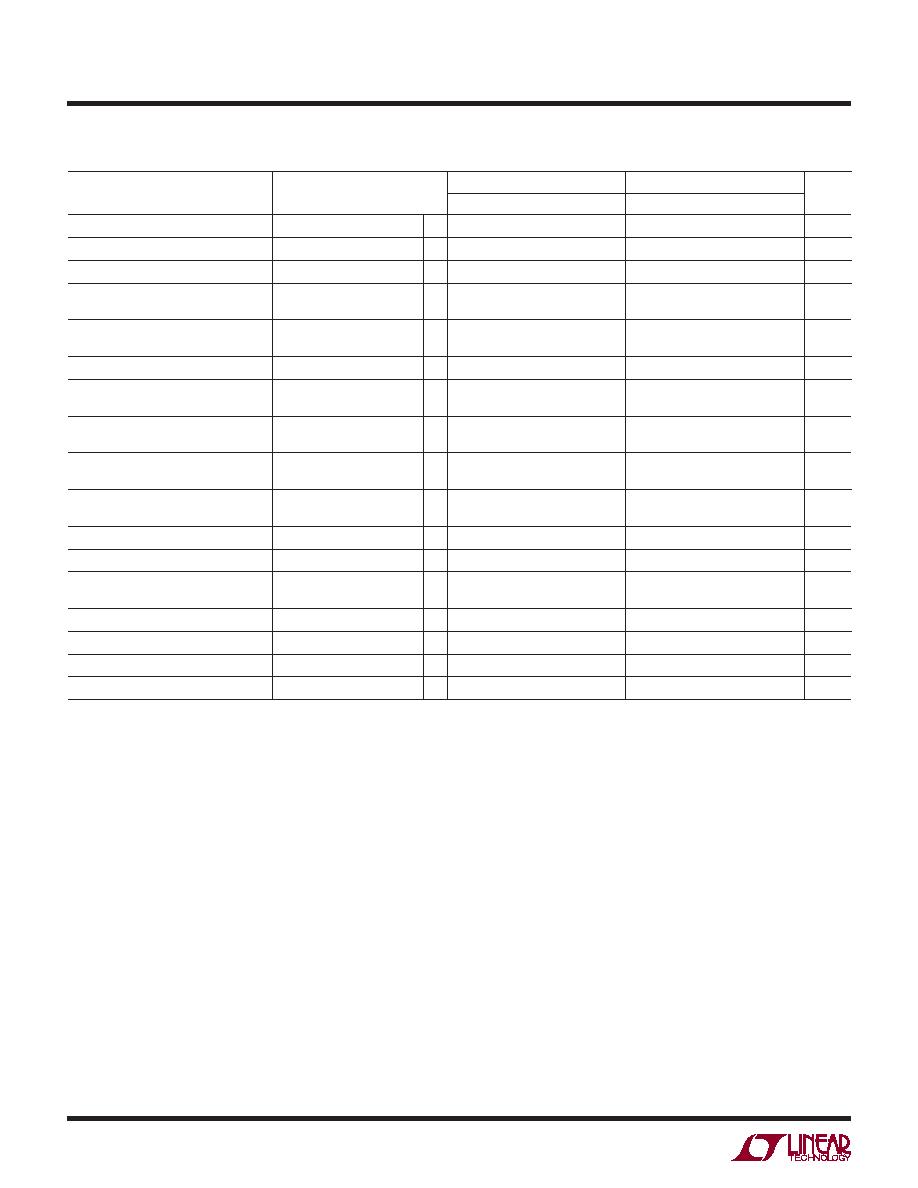- 您现在的位置:买卖IC网 > Sheet目录3515 > LTC2050HVHS6#TRM (Linear Technology)IC OP AMP ZERO-DRIFT SOT23-6

LTC2050/LTC2050HV
6
2050fc
ELECTRICAL CHARACTERISTICS (LTC2050HV) The l denotes the specications which apply over the full
operating temperature range, otherwise specications are at TA = 25°C. VS = ±5V unless otherwise noted. (Note 3)
PARAMETER
CONDITIONS
C, I SUFFIXES
H SUFFIX
UNITS
MIN
TYP
MAX
MIN
TYP
MAX
Input Offset Voltage
(Note 2)
±0.5
±3
±0.5
±3
μV
Average Input Offset Drift
(Note 2)
l
±0.03
±0.05
μV/°C
Long-Term Offset Drift
50
nV/√mo
Input Bias Current (Note 4)
l
±25
±125
±300
±25
±125
±4000
pA
Input Offset Current (Note 4)
l
±250
±500
±250
±1000
pA
Input Noise Voltage
RS = 100Ω, 0.01Hz to 10Hz
1.5
μVP-P
Common Mode Rejection Ratio
VCM = V– to (V+ – 1.3)
l
120
115
130
120
115
130
dB
Power Supply Rejection Ratio
VS = 2.7V to 11V
l
120
115
130
120
115
130
dB
Large-Signal Voltage Gain
RL = 10k
125
120
140
125
120
140
dB
Maximum Output Voltage Swing
RL = 2k to GND
RL = 10k to GND
l
±4.75
±4.90
±4.94
±4.98
±4.50
±4.85
±4.94
±4.98
V
Slew Rate
2
V/μs
Gain Bandwidth Product
3
MHz
Supply Current
VSHDN = VIH, No Load
VSHDN = VIL
l
1
1.5
25
1
1.6
25
mA
μA
Shutdown Pin Input Low Voltage (VIL)
l
V– + 0.5
V
Shutdown Pin Input High Voltage (VIH)
l
V+ – 0.5
V
Shutdown Pin Input Current
VSHDN = V–
l
–3
–20
–3
–20
μA
Internal Sampling Frequency
7.5
kHz
Note 1: Stresses beyond those listed under Absolute Maximum Ratings
may cause permanent damage to the device. Exposure to any Absolute
Maximum Rating condition for extended periods may affect device
reliability and lifetime.
Note 2: These parameters are guaranteed by design. Thermocouple effects
preclude measurements of these voltage levels during automated testing.
Note 3: All versions of the LTC2050 are designed, characterized and
expected to meet the extended temperature limits of – 40°C and 125°C.
The LTC2050C/LTC2050HVC are guaranteed to meet the temperature limits
of 0°C and 70°C. The LTC2050I/LTC2050HVI are guaranteed to meet the
temperature limits of –40°C and 85°C. The LTC2050H/LTC2050HVH are
guaranteed to meet the temperature limits of –40°C and 125°C.
Note 4: The bias current measurement accuracy depends on the proximity
of the supply bypass capacitor to the device under test, especially at ±5V
supplies. Because of testing limitations on the placement of this bypass
capacitor, the bias current at ±5V supplies is guaranteed by design to meet
the data sheet limits, but tested to relaxed limits.
发布紧急采购,3分钟左右您将得到回复。
相关PDF资料
LTC6079CDHC#TRPBF
IC OP AMP QUAD R-R I/O 16DFN
MAX9922EUB+
IC AMP CURRENT SENSE 10-MSOP
LTC6079CDHC#TR
IC OP AMP QUAD R-R I/O 16DFN
MAX4252ESA+
IC OPAMP R-R LN DUAL 8-SOIC
RMCF0805FT13K7
RES 13.7K OHM 1/8W 1% 0805 SMD
MMS-128-02-L-DH
CONN RCPT 2MM 56POS DL HORZ SMD
929838-02-25
CONN HEADER .100 DUAL R/A 50POS
TSW-133-08-S-S-RA
CONN HEADER 33PS .100 SGL R/A AU
相关代理商/技术参数
LTC2050HVHS6#TRMPBF
功能描述:IC OP AMP ZERO-DRIFT SOT23-6 RoHS:是 类别:集成电路 (IC) >> Linear - Amplifiers - Instrumentation 系列:- 标准包装:100 系列:- 放大器类型:通用 电路数:1 输出类型:- 转换速率:0.2 V/µs 增益带宽积:- -3db带宽:- 电流 - 输入偏压:100pA 电压 - 输入偏移:30µV 电流 - 电源:380µA 电流 - 输出 / 通道:- 电压 - 电源,单路/双路(±):±2 V ~ 18 V 工作温度:0°C ~ 70°C 安装类型:表面贴装 封装/外壳:8-SOIC(0.154",3.90mm 宽) 供应商设备封装:8-SO 包装:管件
LTC2050HVHS6#TRPBF
功能描述:IC OPAMP ZERO-DRIFT SOT23-6 RoHS:是 类别:集成电路 (IC) >> Linear - Amplifiers - Instrumentation 系列:- 标准包装:50 系列:- 放大器类型:通用 电路数:2 输出类型:满摆幅 转换速率:1.8 V/µs 增益带宽积:6.5MHz -3db带宽:4.5MHz 电流 - 输入偏压:5nA 电压 - 输入偏移:100µV 电流 - 电源:65µA 电流 - 输出 / 通道:35mA 电压 - 电源,单路/双路(±):1.8 V ~ 5.25 V,±0.9 V ~ 2.625 V 工作温度:-40°C ~ 85°C 安装类型:表面贴装 封装/外壳:10-TFSOP,10-MSOP(0.118",3.00mm 宽) 供应商设备封装:10-MSOP 包装:管件
LTC2050HVHS6-PBF
制造商:LINER 制造商全称:Linear Technology 功能描述:Zero-Drift Operational Amplifi ers in SOT-23
LTC2050HVHS6-TR
制造商:LINER 制造商全称:Linear Technology 功能描述:Zero-Drift Operational Amplifi ers in SOT-23
LTC2050HVHS6-TRPBF
制造商:LINER 制造商全称:Linear Technology 功能描述:Zero-Drift Operational Amplifi ers in SOT-23
LTC2050HVIS5
制造商:Linear Technology 功能描述:SP Amp Zero Drift Amplifier Single R-R O/P 制造商:Linear Technology 功能描述:SP Amp Zero Drift Amplifier Single R-R O/P ±5.5V/11V 5-Pin TSOT-23 制造商:Linear Technology 功能描述:Zero Drift Op Amp
LTC2050HVIS5#PBF
制造商:Linear Technology 功能描述:SP Amp Zero Drift Amplifier Single R-R O/P 制造商:Linear Technology 功能描述:OP AMP 11V 3MHZ 2V/US 5TSO
LTC2050HVIS5#TR
功能描述:IC OPAMP ZERO DRIFT HV TSOT23-5 RoHS:否 类别:集成电路 (IC) >> Linear - Amplifiers - Instrumentation 系列:- 标准包装:1,000 系列:- 放大器类型:电压反馈 电路数:4 输出类型:满摆幅 转换速率:33 V/µs 增益带宽积:20MHz -3db带宽:30MHz 电流 - 输入偏压:2nA 电压 - 输入偏移:3000µV 电流 - 电源:2.5mA 电流 - 输出 / 通道:30mA 电压 - 电源,单路/双路(±):4.5 V ~ 16.5 V,±2.25 V ~ 8.25 V 工作温度:-40°C ~ 85°C 安装类型:表面贴装 封装/外壳:14-SOIC(0.154",3.90mm 宽) 供应商设备封装:14-SOIC 包装:带卷 (TR)